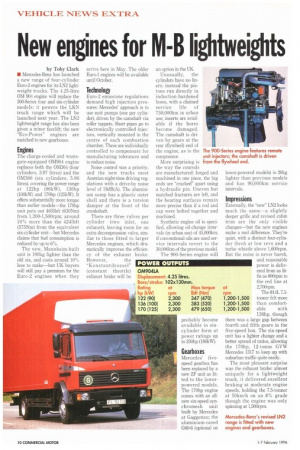New engines for M-B lightweights
Page 12

If you've noticed an error in this article please click here to report it so we can fix it.
by Toby Clark • Mercedes-Benz has launched a new range of four-cylinder Euro-2 engines for its LN2 lightweight trucks. The 4.25-litre OM 904 engine will replace the 300-Series four and six-cylinder models: it powers the LKN truck range which will be launched next year. The LN2 lightweight range has also been given a minor facelift; the new "Eco-Power" engines are matched to new gearboxes.
Engines
The charge-cooled and wastegate-equipped 0M904 engine replaces both the 0M364 (four cylinders, 3.97 litres) and the 0M366 (six cylinders, 5.96 litres), covering the power range at 122hp (90kW), 136hp (100kW) and 170hp (125kW). It offers substantially more torque than earlier models—the 170hp unit puts out 4651bft (630Nm) from 1,200-1,500rpm; around 10% more than the 4241bft (575Nm) from the equivalent six-cylinder unit but Mercedes claims that fuel consumption is reduced by up to 6%.
The new, Mannheim-built unit is 100kg lighter than the old six, and costs around 10% less to make—but UK buyers will still pay a premium for the Euro-2 engines when they arrive here in May. The older Euro-1 engines will be available until October.
Technology
Euro-2 emissions regulations demand high injection pressures: Mercedes' approach is to use unit pumps (one per cylinder), driven by the camshaft via roller tappets. Short pipes go to electronically controlled injectors, vertically mounted in the centre of each combustion chamber. These are individually controlled to compensate for manufacturing tolerances and to reduce noise.
Noise control was a priority, and the new trucks meet Austrian night-time driving regulations with a drive-by noise level of 78dB(A). The aluminium sump has a plastic outer shell and there is a torsion damper at the front of the crankshaft.
There are three valves per cylinder (two inlet, one exhaust), leaving room for an extra decompression valve, similar to those fitted to larger Mercedes engines, which dramatically improves the efficiency of the exhaust brake.
However, the "Konstaritdrossel" (constant throttle) exhaust brake will be an option in the UK.
Unusually, the cylinders have no liners: instead the pistons run directly in induction-hardened bores, with a claimed service life of 750,000km in urban use; inserts are available if the bores become damaged. The camshaft is driven by gears at the rear (flywheel) end of the engine, as is the compressor.
More surprising is the way the conrods are manufactured: forged and machined in one piece, the big ends are "cracked" apart using a hydraulic pin. Uneven but matched fractures are left, and the bearing surfaces remain more precise than if a rod and cap were bolted together and machined.
Synthetic engine oil is specified, allowing oil-change intervals (in urban use) of 45,000km; if conventional oils are used service intervals revert to the 30,000km of the previous model.
The 900-Series engine will probably become available in sixcylinder form at power ratings up to 250hp (186kW).
Gearboxes
Mercedes' fivespeed gearbox has been replaced by a new ZE unit as fitted to the lowerpowered models. The 170hp engine comes with an allnew six-speed synchromesh unit built by Mercedes at Gaggenau; the aluminium-cased G60-6 (optional on lower-powered models) is 20kg lighter than previous models and has 90,000km service intervals.
Impressions
Externally, the "new" LN2 looks much the same—a slightly deeper grille and revised cabin trim are the only visible changes—but the new engines make a real difference. They're quiet, with a distinct four-cylinder throb at low revs and a turbo whistle above 1,600rpm. But the noise is never harsh, and reasonable power is delivered from as little as 800rpm to the red line at 2,70Orpm.
The 814L 7.5tomer felt more than comfort able with 136hp, though there was a large gap between fourth and fifth gears in the five-speed box. The six-speed unit has a lighter change and a better spread of ratios, allowing the 170hp, 12-tonne GVW Mercedes 1317 to keep up with suburban traffic quite easily.
The most pleasant surprise was the exhaust brake: almost uniquely for a lightweight truck, it delivered excellent braking at moderate engine speeds, holding the 7.5-tonner at 50km/h on an 8% grade though the engine was only spinning at 1,500rpm.
































































































